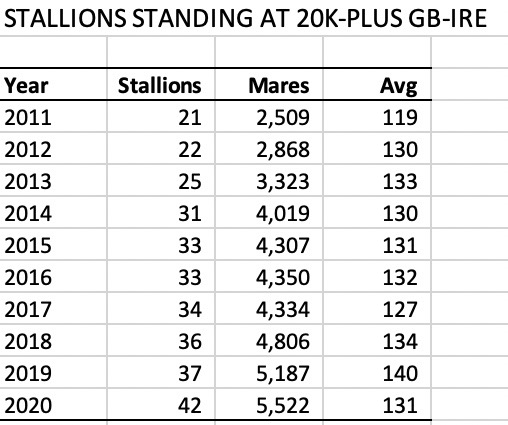The upcoming covering season will tell us a great deal about how breeders really feel about the state of the bloodstock market. Commercial breeders have sold all or at least most of their young stock, albeit for less money that they could have hoped for prior to the pandemic.
Now it’s time to sow the seeds for the foal and yearling sales of 2022 and 2023. How bullish will breeders be next spring? Will the softening of nomination fees help drive demand for nominations? Or will there be a contraction in the market?
With the pandemic raging in March this year and all the uncertainty it brought to the breeding industry, breeders it seems just carried on getting their mares covered. There was no discernible fall in activity in the covering sheds across Britain and Ireland. In fact, 2020 was the culmination of a ten-year success story for the stallion business on these islands.
The volume and value of business is at an all-time high and the only thing restraining it from further growth is a yearling market that had been edging up incrementally prior to 2020. It’s clear that growth in the nominations market was already outstripping growth in the yearling market prior to this year, thus putting some strain on profitability.
To get a sense of how successful the stallion markets has been in recent times we can look at the 20k-plus stallions in Britain and Ireland. Back in 2011, only 2,509 mares were covered by a stallion standing at £20,000-plus or €20,000-plus. Ten years later in 2020, that number had doubled to 5,522 mares. And yes, 2020 with its dark Covid cloud directly above, was a record year for mares visiting elite stallions.
Moreover, although average book sizes are responsible for some of the growth, it is the sheer number of stallions employed nowadays at 20k-plus that account for the vast majority of the increase. In 2011, 21 stallions stood at this level and by 2020 that count had doubled to 42 – again a record number.

On the face of it, we ought to be pleased that the owners of so many mares have the budgets to employ elite stallions. That in itself is a sure sign of a booming market. But, of course, there are always unintended consequences. The squeeze on profits come sales time is the obvious one, but there are also other more subtle consequences at play.
Ten years ago, the 21 stallions advertised at 20k or higher attracted an average book of 119 mares – 15 fewer than the average book covered by the same cohort in 2020. But here’s the rub: the number of elite mares per stallion has fallen from 60 to 39 in the period. So, we have a situation of bigger books but with less quality. And we are all aware that it is the elite mare that can make a marked difference to a stallion’s output of black-type winners.
Even the best stallions need the good mares: Dubawi sires 19% Stakes winners from his elite mares, compared to 12% from his non-elites and the same is true of Galileo (22% versus 11%) and you can rest assured that Frankel’s 15% Stakes winners is built on a solid foundation of elite mares. Adding more and more mares does not equate to more success. In fact, it can appear to have the opposite effect.
The number of mares visiting elite British stallions has increased dramatically in the past ten years. Back in 2011, British-based sires accounted for only 17% of the mares visiting 20k-plus stallions. But by 2019 its share had burgeoned to 40% of that market. It’s easy to see why with the likes of Dubawi, Frankel and Kingman good enough to attract the very best in Europe.
Britain’s share, however, fell back to 33% in 2020, which almost certainly had a Covid-related element to it, possibly discouraging mares travelling from Ireland and France. It was also notable that Ireland stood four out of the six new stallions in this price bracket in 2020, which could also have a bearing on the swing back in favour of Irish sires.
Whatever shape the mare market takes in 2021, one thing is certain: despite the lowering of fees, by my calculations there are still as many as 41 stallions slated to cover at fees of 20k or more. Let’s see if they continue to get their quota of mares.



